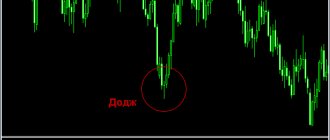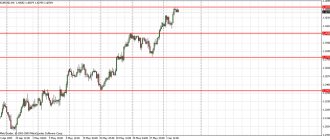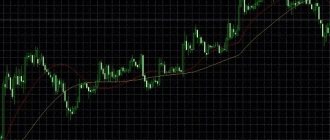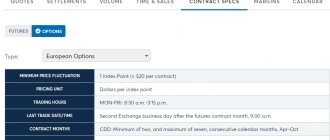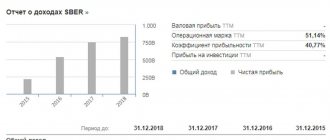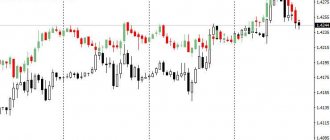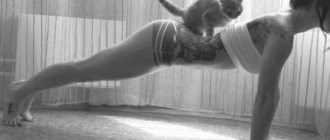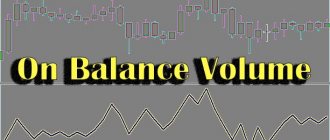What are support and resistance levels on a chart and how to draw these lines correctly?
The main task of technical analysis of financial markets is to determine the trend on the chart. The value of an asset may rise or fall. Thus, any trend during the trading process becomes either increasing, “bullish”, or decreasing, “bearish”.
Also, during a certain period of trading, a sideways trend can be observed, when the forces of upward and downward directions are practically equal for some time, and the price does not move either up or down.
Drawing resistance lines and support lines is the basis on which stock market analytics is built. These levels allow you to determine the current trend on the chart
Why are support and resistance levels formed?
To understand why levels form, we must look at the supply and demand curve.
Notice how on the supply curve, the number of units for sale increases as the price increases. To put this in trading terms, the higher the price, the more traders want to sell their positions.
The demand curve, on the other hand, is completely opposite. As the price increases, the number of units for sale decreases. Traders are less willing to make purchases at higher prices.
We can refer to support and resistance levels as the place in the market where traders are more willing to buy or sell depending on current market conditions. This creates a collision zone between buyers and sellers, which often causes the market to change direction.
Dynamic trend lines
Trend lines are used by almost all traders, since it is unrealistic to build a strategy and trade without an idea of the direction of market movement. Any trading system requires an understanding of the prevailing vector of price movement, which is impossible to determine without drawing a trend line.
A trend line is a dynamic support level, which at a certain point turns into a resistance level. If support/resistance levels are built horizontally to cut off false points and unimportant extremes, then the inclined channel in the form of two inclined levels, from which the price bounces, consists of dynamic trend lines.
Trend lines are usually different for time periods. When the direction of price movement changes on a large scale, the trend lines on all timeframes are tested and broken through. The only exceptions are trends that have existed for decades. It may take decades more to replace them.
The smaller the timeframe, the more often you need to monitor and redraw dynamic trend lines.
The True Trendline Forex indicator is often used for this. A simple and convenient tool that draws current trend lines in accordance with the specified settings.
What are the levels?
Support level is an area on the chart with potential buying power.
Resistance level is an area on the chart with potential strength for sellers.
When the price breaks a support level, the support becomes resistance.
Conversely, if the price breaks the resistance level, the resistance becomes support.
On higher time frames, support and resistance levels become more powerful.
It is important to pay attention to the nature of price movement from the level:
- If the price immediately reverses from the level into the opposite trend, then this level can be considered significant.
- If the price tests a certain area several times, making a small rollback, most likely, this level will subsequently be broken.
Swing zones are places where price returns to a previous pullback in a downward or uptrend. If the trend is not very strong, the price usually tends to return to the border of the previous correction and then continue its movement.
How to understand that the level has been broken?
Sometimes there is a zigzag price movement on the chart. Because of this, it can be confusing which level belongs to what. The price zigzags and breaks through it back and forth.
Therefore, there is a very simple criterion for levels. To understand that the level has been broken, you need to look at the two closing prices of the candles at the level. If the level was broken for the first time, and then it was broken again, this means that the level was broken. There is nothing complicated about this, the main thing is to carefully follow the schedule.
How to draw levels on a chart?
Support and resistance levels are not lines on the chart, but areas or zones. There is no need to try to draw them exactly according to the shadows or bodies of the candles.
Strive to achieve the maximum possible number of price touches on the levels. Typically this will require you to move the level up and down until you find a place where the market will touch that level the maximum number of times.
You don't need to rewind the chart far to note all the important levels. Most often, traders look only at the current monitor screen. Therefore, 100-150 candles will be enough. Most of the levels you will need will be based on price movement over the past six months.
Focus on key levels that are immediately visible. Don't draw too many levels on the chart. Try to keep only the main ones and discard the minor ones. If you find yourself spending too much energy searching for levels, you're probably drawing more levels than you really need.
How to find levels if you are a beginner?
It can be difficult for beginners to see peaks and troughs on a chart. This is because they don't have enough experience. In this case, switching the graph to linear mode can help you.
At first, it will be better to use it.
In the future, you will be able to do this on a regular chart with candles or bars. I will say right away that it is very important to learn how to work with a regular chart, because it displays the extreme price points, tails and shadows of candles, and the constructed levels without them will be, to put it mildly, inaccurate.
You can also use the ZigZag indicator to practice building levels:
It will help you mark levels on the chart:
But I recommend that you do not use indicators, but find levels manually.
Pay attention to price confirmation of levels
The ability to correctly draw support and resistance levels on charts is directly related to your success in trading. Trying to trade without levels is like trying to drive a car with your eyes closed. It's only a matter of time before you get into an accident.
Any price movement at the level signals an increase in demand or supply. The price is clearly reflected in price action patterns, which inform us about the probability of maintaining the level. Let's take a pin bar as an example:
A pin bar at the level tells us that this key support level is in high demand. This is a great example of a level being confirmed by a price action signal.
Consider the following example:
Notice the triangle pattern followed by three support levels. It should be noted that these levels were drawn before the triangle was broken out. Identifying key support and resistance levels should always be your top priority when opening a new chart.
Next we see a bearish price movement, which provided us with a signal to open a short position:
The price confirmed the key support level from which the formation of the triangle began. This is a great place to set a take profit when trading a breakout.
The chart below shows how price reacts to key levels:
What you see above is the heart and soul of price action trading. To be successful in trading, it is not enough to simply find pin bars or inside bars. It is important to read price action at key levels.
Therefore, it is not enough to simply carry out a level. The market should confirm the levels you noted. Otherwise, you will trade what you want to see, and not what is actually happening in the market. Of course, the market won't always test your levels. And that's okay. Don't be afraid to continually adjust your levels. The market is a great teacher and is always ready to show you how accurate your levels are.
It is not enough to simply see a buy or sell signal. We must use the clues the market gives us to gain a statistical advantage and protect our capital. We get these clues by observing how the market reacts to the support and resistance levels we have drawn.
Trading by levels
Support and resistance are used in binary options and Forex. The most common trading options are for a rebound or a breakout. After all, usually the price, when it encounters strong support/resistance, turns around or shows strength and passes through a level lower/higher. Before entering a trade, it is advisable to confirm signals with candlestick patterns, volume indicators, and other methods.
Rebound from level
This is a classic level trading system. It is based on the assertion that the price will rebound from the nearest support along the trend.
Basic conditions:
- Transactions are opened only in the direction of the trend.
- The ratio of profit to risk is at least 3 to 1.
- The stop loss is set a couple of points above the support.
- Profit is fixed at the nearest level.
Level breakdown
The idea is quite simple and is based on the assertion that sooner or later the price will definitely break through the level (from top to bottom - breakdown of support, from bottom to top - resistance). Trading on a level breakout is significantly complicated by the possibility of false breakouts, after which the price returns back. They make a loss in this strategy.
As an example, consider trading a resistance breakdown. Trade with pending orders. A pending order BUY STOP is placed not far from the resistance (7-10 points above the price extremes). STOP LOSS is set below the resistance level to protect against a false breakout. TAKE PROFIT is placed at a distance 2 times greater than the distance to the stop loss.
In the example, first there was a false breakout, then the price went up and broke through the resistance level. Then the price usually moves quickly, moving a significant distance from the previously broken level.
Work on a breakdown of the support level is carried out in the same way, only instead of a BUY STOP, they place a SELL STOP order and wait for the price to break down. To filter false breakouts, it is advisable to use indicator signals.
False breakout
Regardless of the type of false breakout, it is always a signal of further price movement in a different direction. The trader should wait for the price to return below the level (you can wait for a small trade in the value near the level), and then open a position in the opposite direction from the false breakout. Stop loss is set at a level below/above consolidation (in accordance with the price direction). Take profit is placed at the nearest level.
You can enter a position after a false breakout without triggering, using Price Action patterns. Then the stop loss is placed in accordance with the rules for working with patterns. Take profit is placed under the closest level or according to the rules for working with the model.
False breakouts are common in Forex and always signal a change in trend, at least temporarily. This is a kind of deception of the crowd, since when it appears, many traders enter a position without confirmation and receive losses, since the price changes direction and returns below the level again. Stop losses are triggered, and after a false breakout the price moves sharply in the opposite direction.
To avoid falling into this trap, traders are advised to use Price Action or VSA patterns, thanks to which they can determine the situation on the market. For example, using VSA, when a breakout occurred without volumes, it is most likely false.
Trading in a horizontal price channel
Before starting trading, several additional lines are drawn. The first one is to set aside 50% of the total width of the range (it turns out to be exactly halfway between support and resistance), the second and third ones are placed inside the channel, at a distance of 5-10% of the width, parallel to the lower and upper boundaries.
Trade in channels from resistance/support lines (which act as channel boundaries). When the channel rises near the lower border, they buy, and when it rises near the upper border, they sell. Income is fixed at the opposite border when the price goes beyond the 5-10% line. This way we can minimize risks.
Another important level of support and resistance is the 50% line. You need to enter a trade from it carefully, in the direction of the channel. Stop loss can be removed for past significant price extremes.
At least two extremes
The support or resistance line must be horizontal and pass through at least two minimum/maximum price values (also known as extremes).
What extrema does the line pass through:
- Maximum + maximum for resistance.
- Minimum + minimum for support.
- Maximum + minimum for mirror level.
Don't look for easy ways
Many traders, in their desire to learn how to trade quickly and easily with big profits, try to find the simplest ways. One way or another, you need to be able to read a chart, and technical analysis involves not only blindly following several rules, but the ability to understand current events in the market and react flexibly to them.
Using support/resistance levels in your work, you need to have the widest possible knowledge about these instruments, be able to distinguish between the main indicators and situations, apply indicators and patterns, and other methods of analysis to eliminate false signals.
How to avoid mistakes in building levels?
Each trader has his own method for drawing support and resistance levels. However, the levels are not always carried out accurately. Some of these problems are due to misunderstanding of levels, since there is nothing more subjective in technical analysis than drawing support and resistance levels.
Sometimes it takes years to train your eye to identify true support and resistance levels, which are the basis of any profitable trading strategy. But it normal. Your goal shouldn't be to play perfect levels the first time. You should try to mark the levels to the best of your ability while remaining open-minded in your analysis. Always allow for the possibility of making a mistake. You should never be too convinced that you are right.
Here's an example where I made a mistake about the key support level. Initially, I used a level drawn through price lows.
It's no surprise why I drew this level: price has repeatedly tested the marked area as support. However, a few weeks later, the price decided to retest the 1.5465 level as resistance. When the testing candle closed, I realized that this level needed to be adjusted.
The market closed above the 1.5465 zone. However, instead of viewing this level as an area of resistance the next day, it closed 17 points lower.
Although this price action was explained as a false breakout, the inconsistent price movement was enough reason for me to question the validity of this level. So I started moving it around to see if the market was actually trying to tell me something.
The 1.5475 level seemed more appropriate to me given the price action over the past few months. Although the difference was only 10 points, I felt much more comfortable using the new level.
One of the most dangerous mistakes is your overconfidence in the reliability of the levels. You should always pay attention to recent market actions that either confirm or refute current levels. The market is dynamic and constantly changing. This is especially true for the forex market since it is open 24 hours a day.
Drawing support and resistance levels is always subjective. If you have the most accurate levels marked, you are more likely to be correct in your prediction. Determining market entry points, setting stop losses and profit targets are also subjective, but these things largely depend on the levels drawn.
Confidence is key to being a successful trader, but when confidence turns into stubbornness, you can be in serious trouble. Be flexible, not stubborn. Try to mark the levels as accurately as possible, always taking into account the price movement. You could be wrong by 5 or even 50 points, but the market will always tell you if you remain open to its signals.
Don't get too carried away with rearranging levels. Sometimes novice traders try to move levels in order to find a price action signal suitable for trading. For example, they move the level to a pin bar in order to open a trade on it.
The chart below shows how the support level has been moved to the tail of the pin bar, however this level does not at all reflect the previous highs of the candles. As expected, the bullish pin bar falls short.
The tail of a pin bar tells us where the level of supply or demand is in the market. But this type of signal is only valid if it occurs at a key support or resistance level.
Characteristics
Support/resistance levels suggest certain properties and characteristics, which are also important to study before using them in trading.
Number of touches
The more times a level has been tested by the price, the more important it is considered. The more often the price has been stopped by support/resistance levels, the more likely a breakout or pullback may be. The mechanics of the foreign exchange market indicate that the more often the price reacted to the support level, the fewer buy orders will remain.
The best time to sell is after price has touched resistance during the first return from a failed breakout.
Levels on higher timeframes
At older time periods (day/week/month), levels become more important. The same goes for trend lines. It is the higher time frames that large players usually look at, who are capable of greatly moving the market.
On small timeframes, levels and lines can also be used, especially when it comes to liquid currency pairs, where even small time periods lend themselves well to technical analysis and its tools.
Touch zones
Pay attention to the number of touches and their quality. The strength of support/resistance largely depends on the magnitude of the pullback. When the price reverses and forms a V, creating new highs and lows, the levels are considered stronger because the market is showing quite strong rejection of the level.
Trend line angle
The following rule works: the steeper the angle at which the trend line passes, the faster and easier it is for the price to cross it (a minimal sideways movement is sufficient for this). Any trend line breaks through sooner or later. And lines with a steep angle intersect more often than those with an angle of less than 45 degrees.
Everything is simple here: trends with a gradual change in value usually last longer than sharp spikes in volatility, which always end in a correction. A breakout of a line with a steep angle does not always indicate a reversal; it may be a rollback with the beginning of a smoother movement.
- Pay attention to our signals + Forex forecasts for each day (it is based on trend lines, channels, levels):
The slope of the line varies greatly depending on the data available and the graph used. When zooming out/increasing, the angle may change.
Arithmetic graphs are different from logarithmic graphs. Despite this, when analyzing the same chart, the slope of the trend lines is necessarily taken into account.
Support and resistance levels and time frames
Let's try to understand the relationship between key levels and timeframes.
You may have noticed that levels do not always reproduce well across multiple time frames. For example, a level may look good on the daily chart, but on the four-hour chart the level has already been broken.
Notice how well this level holds on the daily chart. All candle bodies in the selected areas are above or below the key level without overlap.
Now let's look at the same level on the four-hour timeframe:
The four-hour chart above shows a retest of this key level as new support. Please note that the body of the candle closed below the level.
At first glance, this looks like a breakout of the level, which could lead to a fall in price. But that's not true. Why? Because the market is interested in supporting this level only on the daily timeframe, and not on the four-hour one.
Let's compare these two timeframes side by side. The level represents the same price on both charts:
The fact that a false breakout occurred on a lower timeframe tells us that the market is interested in maintaining this level only on the daily chart. This means that we must trade at this level not lower than the daily timeframe.
Defining and drawing lines
In order to build support and resistance levels as efficiently and correctly , it is better to start construction from the extreme parts of the consolidation area (Congestion Zones). But using maximum and minimum price indicators for this does not make much sense, since their effectiveness in solving this problem leaves much to be desired. The whole point is that the locality of minimums and maximums is just a panic of small trading participants. In turn, the outskirts of consolidation zones make it possible to understand where strong market players changed their decisions.
Basic moments
Strong Resistance and Support lines are the reason for the change in trend direction. If the boundaries do not have sufficient strength to reverse the trend, the trend will only pause for a short time. As for trading along these lines, traders most often sell their assets when the price reaches the Resistance , and buy them when contact occurs at the Support .
The properties of support and resistance levels are very important when developing trading systems and analyzing market conditions. Resistance and Support act as a kind of “ mirror ”, reflecting the general mood of sellers and buyers regarding certain assets.
Whenever the value of an asset reaches these limits, we understand that the market and its participants have changed their mood.
It is generally accepted that reaching a certain limit is a kind of signal . We can interpret it this way: one part of the market players has lost the desire to sell assets, while the second part has no interest in buying them. Thus, at this moment we are faced with a drop in trading volumes and a market freeze .
Resistance and Support act as a kind of “mirror”, reflecting the general mood of sellers and buyers regarding certain assets
Trading by levels
To give you an idea of how to trade by levels, I will give you a vivid example of the price reaching the Support . In this case, the price parameter is moved downward by sellers with a bearish trading style, but does not find the necessary support from them due to the reduction in buyers with a bullish style in the market. The reason for this is the rapidly falling value of assets, scaring away buyers. In this case, the market finds itself in a state of “ oversold ”, and the value of the asset drops to a psychological limit, beyond which trading is simply not interesting under current conditions.
If the price parameter reaches the Resistance , then we have the opposite situation. Despite the fact that it is impossible to determine how the price will behave in such a situation, statistics say that in most cases it bounces off the border and goes in the opposite direction. An exception can be considered cases with a strong trend movement, when a temporary price stop still ends with breaking through the border and continuing the movement in the given direction. In this case, we are faced with the return of life to the market and either the price breaking through an important psychological level or pushing away from it. At such moments, there is a significant jump in trading volumes .
If we consider the levels from a technical point of view, they are lines drawn through the values of the price parameter that are approximately at the same level. In the case of Support, the line passes through the minimum price values , and with Resistance - through the maximum . The levels themselves are not exact values, but only occupy a certain price range , which has a range of tens of points in both one and the other direction.
In order to help you choose a reliable broker to work with, I have compiled the data in a convenient table.
| Company | Just2trade | United Traders | BKS | Tinkoff investments |
| Minimum deposit | From $100 | $300 | from 50,000 rub. | Unlimited, you can even buy 1 share, they recommend starting from RUB 30,000. |
| Commission per cycle (buy + sell trade) | 0.006 USD per share (min. 1.5 USD), 0.25 USD for each application. that is, per lap – $3.50 | “Beginner” tariff – $0.02 per share Average $4 per round | At the “Investor” tariff – 0.1% of the transaction amount, at the “Trader” tariff it is reduced to 0.015% | 0.3% for the “Investor” tariff |
| Additional charges | The ROX platform will cost at least $39/month. (for the American market), for an additional $34.50 they connect Canada/TSE, Level II On the over-the-counter market, the additional fee is 0.75% of the transaction volume (minimum $30), in the case of dividends - 3% from the issuer (minimum $3) | On the Day Trader tariff, they charge $60/month for the Aurora platform, free on other plans | If the account has less than 30,000 rubles - 300 rubles/month. for access to QUIK and 200 rub./month. for access to the mobile version of QUIK, | — |
| Account maintenance cost | $5/€5/350 rub. reduced by the amount of the commission paid | — | 0 RUR/ month on the “Investor” tariff. On other tariffs, funds are debited only if there was activity on the account this month | Free for the "Investor" tariff |
| Leverage | for Forex Up to 1 to 500 for stocks up to 1 to 20 (day) to 1 to 5 (night) | 1 to 20 on the Day Trader tariff, this is the maximum leverage (daily) | Calculated for each share, within the range of 1 to 2 – 1 to 5 | Calculated for different instruments, the calculation is linked to the risk rate |
| Margin call | -90% | Standard -30% of the deposit, in technical terms. support can be set -80% | Calculated based on the risk for each security | Depends on the asset |
| Trading terminals | MetaTrader5, ROX | Aurora, Sterling Trader, Fusion, Laser Trader, Volfix.Net, Pair Trader | My broker, QUIK, WebQUIK, mobile QUIK, MetaTrader5 | The purchase of shares is implemented like an online store, professional software is not used |
| Available markets for trading | Forex, American, European and other stock markets, cryptocurrency | American and other stock markets, more than 10,000 assets in total, cryptocurrency | Foreign exchange, stock, commodity markets, there is access to foreign exchanges | American and Russian stock markets |
| License | CySEC | Lightweight license from the Central Bank of the Russian Federation | TSB RF | TSB RF |
| Open an account | Open an account | Open an account | Open an account |
Direct construction
The rules for constructing support and resistance lines are quite simple. All you need to do is to find two price values, minimum and maximum , respectively, in the selected time period. It is these that we will use as supports in our construction. It should be noted that in many cases Resistance also takes on the role of Support. This happens due to the fact that the value of the asset, having managed to overcome the Resistance limits, did not change direction, but reached the next level, which was no longer possible to overcome. Having fought off the latter, she headed back to Resistance, which now acts as Support.
If you are already thinking about how you will set support and resistance levels, then I can make you happy.
To do this, you do not have to resort to any indicators or templates. To draw boundaries, you will only need the standard tools contained in the MetaTrader5 or Transaq terminal panel. Personally, I find the most convenient tool to use is a simple horizontal line. Using it, set the boundaries in which the local maximums and minimums of the price parameter will be located.
Unfortunately, no trader can make a forecast with 100% accuracy. No one knows for sure how the price will behave after approaching the level: will it bounce away from it and change direction, or will it break through it and continue moving along the given route. Therefore, if you do not feel confident in your own abilities or feel a lack of experience, perhaps it makes sense for you to think about how to choose a broker on the stock market. A professional intermediary not only knows how to choose stocks for investment, which assets are best to invest in at the current moment in time, but is also well acquainted with the intricacies of technical analysis, which is so important for a profitable investment. Personally, I use the services of the broker just2trade . To register, click on the button below.
Broker website just2trade
Plotting support and resistance levels on daily charts
Let's talk about building support and resistance levels on daily charts. If you think that there is nothing fundamentally new in this, and that all levels at all time intervals are set the same, then you are deeply mistaken.
If you have been trading price action for a long time, then you already know that daily candles carry a much larger amount of information than candles on H1. If we take each candle as a history of the battle between bulls and bears, then the overall picture will be better visible over a larger period, since we see where the attack of certain forces began.
The candle on H1 can be compared to a small fortress, the capture of which cannot show us the strength of the attackers and defenders. And the candle on D1 is a regional city, the capture of which can play a decisive role in the overall outcome of the war.
If we accept the fact that daily candles really carry more information, then every spike should be important for us, since its tip is the point of preponderance of certain forces.
There are two levels marked on the chart, the blue dotted line is the level at the closing and opening prices, and the red dotted line is the level at the spike.
The blue line mercilessly made its way in all directions, the market did not respect it, since it only tells us about the place where the bears managed to get. Look at the level from the spike. As we can see, the market made a significant upward rebound from it, after which it broke through it, corrected to it and moved down. This is because the spike is the point of preponderance of power, because it was at this point that the bulls began to attack the bears, and this tells us that there are a lot of buyers in this place.
But there are still some points that should be taken into account when building levels:
The market must have a clear direction
The price cannot be in consolidation, or in a small range, as this will not allow the second point to be determined.
Local maximum or minimum
This point should be a local maximum or minimum. In other words, if we have a large spike that stands out, then we should wait for the next candle to close. If another candle blocks the spike, then we will consider the level to be failed.
In the first example, the previous candle overlaps the spike, which does not allow us to set the level correctly. In the second example, the next candle blocked the spike, which indicates to us the weakness of the bears.
The market is constantly moving and at the same time it stops for breaks. It is these stopping moments that we will use to identify the best support and resistance levels, since the latest information about the location of the forces of bulls and bears is important to us.
The marked places are price stopping points, but as we can see, not all of them would indicate to us a good location of a strong and quality level. Therefore, it is necessary to introduce a kind of filter that would help us choose only the best places.
Recent events + history check = good level.
The points where the price made recent stops are marked in red. These places are the latest events in the market. Next, we draw levels at these points and look for rebounds from them. If they exist, and the price rarely breaks through this zone, then we will identify the quality level. If we do not have any price rebounds from the level, then it is better to ignore this point and wait for its confirmation in the future.
Why are recent events so important?
The fact is that the market is constantly in motion due to the fact that bulls and bears alternately take control over it, and those points where these price reversals occur can give us information about the location of certain forces.
The price can stop for two reasons, the first is known to everyone - the market has encountered strong resistance.
The second reason is that the attacking party simply closed their take profit orders, which created a preponderance of power and the market moved in the opposite direction. In other words, there was no strong resistance, there were simply fewer participants in the attack. All that remains is to make a logical conclusion - if the market stopped in a certain place due to the closure of take profit transactions, then we cannot consider this point as the basis for constructing support and resistance levels.
How can you find out that take profit orders were closed in this exact place?
Let's remember our formula: recent events + history check = good level.
Basic mistakes when working with supply and demand zones
When planning to trade using support/resistance levels, it is advisable to study the most common misconceptions and mistakes. It is always better to learn from someone else's experience than from your own losses.
Common misconceptions and mistakes:
- Levels are always drawn as clear lines that you need to follow - this is far from the case. Not only can a trader draw the levels incorrectly, but even with the correct choice of extremes, the price will not strictly follow the rules. Levels are more areas of interest than clear lines.
- Ignoring subsequent market movements is also common. Having drawn the levels, the trader is sure that this is enough and does not look at further price actions or take into account important changes.
- Marking on the chart all kinds of levels that can be found - traders spend hours looking at dozens of levels, which then do not give any effect. Only really important elements that are part of the trading system need to be plotted on the chart.
- Clear markings of levels along the highs/lows of tails, candle bodies - this is not always the case, often levels pass through the middles of tails, sometimes even candle bodies.
- Going back far into history to build – this makes no sense. It is advisable to choose adequate intervals that correspond to the type of trading and the selected timeframe.
How to use support and resistance levels in trading?
A level is a place for a possible entry into a trade. If an additional confirmation signal appears at the level, you can think about opening a position. Stop losses are placed at levels and possible targets for taking profits are determined.
In books on technical analysis and on the Internet you can often read that the more often the price tests a level, the stronger it is. But this is a grave mistake. In fact, the more the price touches a level, the weaker it becomes.
Let's imagine that we have a support level. The price bounces from this level because there are buyers in the market. If the price often returns to the level, this means that buy orders are gradually being executed. And when they are completely filled, who will buy then? Therefore, when there are no buyers left, the price breaks through the level.
It is also very important to observe the size of the candles where the price approached the level. If the candles were large, the price will most likely bounce off the level. If the candles were small and gradually approached the level, forming a triangle figure, a breakdown of the level will most likely occur.
It is important to remember that support and resistance levels are primarily zones, and not exact lines on the chart. Otherwise, you may encounter two problems in your trading: the price does not reach the level and goes beyond it.
When the market gets close enough to a level without touching it, you may miss a trade because you were expecting a trade setup to occur at exactly the level you chose.
In a situation when the price goes beyond the level, you think that there has been a breakout of the level and try to trade the breakout. But this often turns out to be a false breakout.
How to solve these two problems? Very simple. Always think of support and resistance as zones on your chart rather than precise lines.
There are two groups of traders:
- Traders who are afraid of missing out on a deal.
- Traders who want to enter the market at the best possible price.
Traders who are afraid of missing out on a trade enter the market when the price approaches the level. And if there are many such traders, the market will change its direction exactly in this place.
On the other hand, there are traders who want to get the best possible price, so they place their orders a short distance from the level. If such traders become the majority, and traders who are afraid of missing out on a deal become the minority, the price will break through the level and only then change its direction.
You can never know which group of traders will dominate the market at a given time. Therefore, do not forget that support and resistance levels are precisely areas on the chart.
How to set a stop loss when trading from levels?
Never place your feet exactly on the levels or a short distance from them. Because market makers will always be after your stops.
How can you avoid such situations?
First, you can use the ATR indicator and set a stop at the ATR distance from the level, adding the spread size here. Secondly, you can exit the trade only if the price confidently closes behind the level.
Most often, the real movement in the market begins only after market makers have gained maximum liquidity by collecting stop losses from most traders.
Do not open your positions when the price is between levels
A serious mistake many traders make is that they enter the market at a time when the price is far from the level. Such entries require a much larger stop loss and therefore the risk to reward ratio is suboptimal.
But if you let the price get closer to the level, then your stop loss won't be as big.
How to know that a level breakdown will happen?
As we already know, support is an area with potential buying pressure. Therefore, when the price approaches the support level, it should reverse into the opposite trend. But what if this does not happen and the price begins to consolidate at the support level?
This is a sign of weakness as the bulls cannot decisively push the price higher. Or there is strong selling pressure in the market. In any case, this situation does not look optimistic for the bulls, and support will probably not be able to hold.
Trading strategy for trading by levels
Support and resistance levels attract a lot of attention from many traders. Some of them will trade a breakdown, and some will trade a reversal. Therefore, it is inevitable that some of the traders will lose their money.
Mark the areas of support and resistance on the chart:
Wait until the price reaches the level with a directional movement:
Expect a price rollback from the level:
Enter on the next candle after the pullback, placing a stop loss behind the candle that broke the level:
Take profit at the nearest level:
You must understand that this trading strategy is not a grail that will constantly work itself out. You will have profitable and losing trades. And the only thing that will keep you from losing your deposit is proper risk management.
What is a level?
The level is the point where the trend breaks or “trades”. There is some kind of struggle between sellers and buyers, the outcome of which determines whether the price will continue the initial movement or turn around and go in the other direction. A support/resistance level is any previous peak or trough. Let's look at this clearly on a theoretical price chart.
Let's imagine that we now have a chart with an uptrend.
Let's mark the levels on this chart.
I have highlighted them with red lines:
Also, at the end of our chart, you can notice that the price is at the same level and constantly rests on something. This is called pro-trading.
It can be considered a level, so let’s also mark it with a red line:
Thus, we have found all levels on the chart.
I would like to say right away that a level is not a straight line that coincides point by point with a certain price on the chart, but a zone that includes some space around it:
In this chart, you could immediately see that some local maxima and minima lie on the same straight line. But at the same time, there is one that lies slightly lower than the others. This is normal, because it is still in the area of our marked level.
So, a level is a point of a possible price reversal or, in other words, a place where traders’ activity increases. You probably have a question: “Why is this place so attractive to traders?” A similar market reaction is caused by the accumulation of limit orders from sellers and buyers. Why do they place their limit orders? The answer will be very simple. This is because it is obvious to them where to place the stop loss. This is a feature of human perception, because not only robots, but also people trade in the market.
And besides, I note that robots are programmed by people who realize that people trade in the market. They understand that instead of entering into an unclear space where it is unclear how to set a stop loss, the human brain will look for something to grab onto. He tends to enter the market at such breaks.
A level is a collection of limit orders from sellers or buyers. Since there is high activity of traders at the levels, the levels are a possible place for a price reversal or an increase in its activity.
Support and resistance levels: features and nuances
Let's conduct a small test on your understanding of support and resistance levels:
- The more often support and resistance are tested over a short period of time, the stronger they become. (True False)
- You should set your stop loss below support and above resistance so that it is not hit by price. (True False)
- You should take positions near support because it offers a favorable risk-to-reward ratio for your trades. (True False)
Let's now look at these questions in more detail.
The more often support and resistance are tested over a short period, the weaker they become
In most trading articles you will read that the more often support and resistance are tested, the stronger they become. But this is not true because the more times support and resistance are tested, especially over a short period of time, the weaker they become. And that's why.
Support exists because there is potential buying pressure around a certain price level. This buying pressure could be institutional investors, retail traders, smart money, etc. So what happens when price tests a certain level multiple times? Gradually all orders are executed.
Eventually, when all these orders are filled, there will be no one left to buy, and that's when the support breaks. This means that the more often support and resistance are tested, especially over a short period, the weaker they become. Why am I writing about a short period? Because it is unlikely that new orders will appear so quickly.
The multi-year high is a significant level to pay attention to
Here are a few reasons why this happens.
Traders in losing positions hope to break even
Multi-year highs represent extreme optimism in the markets as most traders and investors make profits. But, as you know, the price cannot rise forever. Eventually it must stop or change direction completely. When this happens, many traders close their long positions.
However, not all traders will do the same. Some will continue to stay in the market, hoping that the price may break higher, bringing them even greater profits.
But when the market drops even lower, they will regret not selling sooner because they are now incurring losses. They hope the market can retest the highs so they can exit their trades at breakeven.
Bearish traders want to short the market
For bearish traders, multi-year highs provide an opportunity to short the market at a "high price" because they can use the highs to set their stop loss. Therefore, when the price approaches multi-year highs, interest from bearish traders will increase.
Momentum traders enter the market for a breakout
Momentum traders buy the breakout when the price rises above a certain level. These could be range breakouts, swing zones, resistance levels, etc.
If the price moves beyond multi-year highs, it will attract the attention of traders on different time frames.
This is because whether you are a day trader, swing trader, long-term trader, multi-year highs will be visible on your timeframe and charts regardless of whether you are bullish or bearish in the market.
If you are bearish, you can use it to place a stop loss above the high. If you are bullish, you can buy the breakout and place stops below previous multi-year highs.
Support and resistance are areas on your chart, not lines
I will share my story with you. In my early days of trading, I used to think that my support and resistance levels were the best and the market would respect them to every point. But it didn't take me long to realize that my support and resistance levels were continuing to be violated, and I believed that they were being broken.
That's why I traded the breakout. Often the price quickly made a reversal in the opposite direction, and my positions were closed in stops. I would look at the graphs and ask myself, “What the hell went wrong?” And that’s when I had an epiphany. I realized that support and resistance are not lines, but areas on my chart. That's why …
Typically there are two groups of traders in the market:
Traders with a fear of missing out on a position enter their trades when the price approaches a support level. And if there is enough buying pressure, the market will turn around in this place.
On the other hand, some traders want to get the best price, so they place orders at support lows. And if enough traders do this, the market will reverse around the support lows.
However, you never know which group of traders will control the situation at the moment. So support and resistance are areas on your chart, not lines.
Support and resistance levels represent a significant area on your charts
You may be wondering, "What's the difference between price and value?"
Price is what you pay, value is what you get. If you go to the supermarket and buy 1 apple for $1, that's the price you pay. And the value you get is an apple you can eat immediately without having to grow an apple tree or pick the fruit yourself.
In other words, the price you pay must be "cheaper" than the value you receive, otherwise the transaction will not be worthwhile. What does this have to do with trading?
Well, you can open your trades at any random price level on the chart, but that doesn't mean you will make a profit. Just like how you don't get much value when you pay $50 for an apple.
How do I find significant areas? These may not necessarily be support and resistance levels. These are often areas where potential buying pressure could push the price higher, such as towards a support level.
It is also not guaranteed that the support will hold, but if it does, the price will soon move back up and return to “fair value”.
You can also use trend lines, moving averages, etc.
When price breaks support, it may become resistance
There are two reasons for this.
Unprofitable traders hope to break even
Support is the area where potential buying pressure can intervene and push the price higher. However, support may not be permanent.
When it breaks, traders who are long will be in the red. Smart traders will cut their losses and move on. But stubborn traders will hold on to their losses and hope the price returns to their entry price so they can break even.
This group of stubborn traders creates selling pressure at their entry price when they exit their positions, and if there are enough of these traders, support becomes resistance.
Breakouts and pullbacks
In trading, the moment of breakout and rollback is often used. A breakout is when the price crosses the line. Usually, the momentum of the movement then sharply decreases, a rollback occurs from the line that was broken, and only after this rollback can the price move further in the direction of the breakout.
A pullback is the best time to enter the market. If the trend moves up, after a pullback the price drops to the last resistance level crossed. If the trend is going down, a pullback is the price returning to the support line that was just broken. A rollback can include one candle or several - a lot depends on the time period. It is best to confirm the rollback at higher intervals.
At the moment of the emergence of a new trend, it seems that certain inertial forces are preventing the price from developing. What the real direction of the trend is becomes clear only when the trend is already in full swing. But trends always emerge from a torn market, they are turbulent and difficult to determine at the beginning.
To use a trend in trading, it makes sense to look for pullbacks when the price still feels the influence of the previous price movement, but a new imbalance between bears and bulls is already noticeable, the level is being tested and the price may briefly go sideways. When it begins to move vertically again, copes with inertia and breaks away from the previous level of support/resistance, this signals that sellers/buyers have seized control. But entering the market before a pullback is risky.
A pullback is usually a short movement, but a lot depends on the time period. The price can move back and forth for several candles: when there is no strong determination to breakout, there will most likely be a rollback. Returning the price to a predictable level allows you to open a less risky position compared to the moment the price is already actively moving far along the trend.
Rollbacks can be observed not only near support/resistance; they often occur near technical analysis figures, pivot points, moving averages, etc.
Can support become resistance?
Consolidation has a time limit. It is observed more often at the Pacific and Asian sessions, and less often at the European sessions. But with the transition to the American trading period, the price resumes its movement. At this point, levels are no longer an obstacle, and support can easily become resistance (and vice versa).
As soon as the price leaves the flat zone, the boundaries that prevent its growth or fall disappear. This is displayed on the chart as a stepwise change in quotes up or down. Each jerk is accompanied by a slight rollback (correction), but the movement continues. A pause occurs at the next level or as a result of the transition of trading into the Pacific and subsequently the Asian session.
Features of trading at levels
The creation of methods for making a profit at Forex resistance levels is based on the “breakout” and “rebound” events. Then there is a division between lovers of aggressive and conservative trading. Here, incompatible ways of determining the point of entry into the market and exit with profit or loss arise.
Typical strategies look like this:
- Aggressive trading: a trade is opened immediately after the breakout, if at least half of the time is left before the end of the period in which the trader is working (there is no point in taking risks when the candle closes; there is a possibility that the opposite one will open).
- Conservative trading: an order is opened only after “confirmation”. This can be the next candle closed behind the broken level.
Conservatives, according to the aggressors, are “wasting time,” but their approaches to making a profit are different. The former strive to squeeze the maximum number of points out of one transaction, the latter are more inclined to exit the market within a minute or less. Stop Loss orders also differ in the number of points. If a conservative approach involves waiting for events to develop and setting a closing point with a loss at the broken level, short-term strategies take into account a short period of time in the market and often do without Stop Loss.
Trading range or trend channel
There are situations in which the simultaneous construction of Support and Resistance is required. This is due to the fact that when the levels are formed in parallel, a kind of trading range is created or, as it is commonly called, Trading Range . Many traders know it as a consolidation zone . Have you heard about technical analysis figures with images and examples? According to them, the rectangle symbol is a trading range, which indicates the continuation of the trend line. That is, there is a fairly high probability that the price will be fixed in this TradingRange over a long period of time.
This is largely due to the high concentration of long and short orders at the boundaries of the trend corridor. Trading performance within this zone improves whenever the market successfully tests support and resistance lines.
If the market breaks through one of the lines, we are faced with a situation where the market either reaches new levels (if it managed to continue the existing dynamics) or a reversal of the current trend.
